Interviews
Egypt's area under cotton harvest projected to decline: US
15 Apr '20
3 min read

Pic: Shutterstock
Egypt's area under cotton harvest is projected to drop by almost 35 per cent to 65,000 hectares (ha) in market year (MY) 2020-21 from 100,000 ha in MY 2019-20, according to the ‘Cotton and Products’ report issued by the Foreign Agriculture Service (FAS) at the US Department of Agriculture (USDA). Egyptian farmers reportedly mixed the cultivation of cotton with tomato, which encouraged whitefly infestation in both crops.
FAS revised down MY 2019-20 production to 305,000 bales compared to expected production of 337,000 bales, attributing that to the reduction of yields due to the lower quality of seeds and losses due to whitefly infestation.
“If uncontrolled, whiteflies can reduce cotton yields and affect cotton quality. Immature whiteflies infest the underside of the leaves and secrete honeydew, which is a sticky, sugary solution. This can be a serious issue in terms of fibre quality or the spinnability of fibres when grinned," the report said.
It said reduced prices discouraged MY 2019-20 cultivation, expecting that this may continue into the coming season.
Previously, the government provided cash payments to the textile industry, which allowed them to pay a government-announced price for Egyptian cotton.
Following the reform of that system, the government announced an indicative price before the planting season commenced. The indicative price is a subtle attempt to urge the textile industry to buy cotton from farmers at the indicative price. However, it is not a price support or commitment from the government to buy the crop, according to the report.
It added that in MY 2019-20, for the first time the government did not announce indicative prices, which will have adverse effects on MY 2020-21 cultivation. In addition, in MY 2019-20, the prices are still low even with the drop in production.
Referring to the deficient supply, the report noted that in MY 2019-20, the yields dropped unexpectedly not only because of the decrease in area cultivated, but also due to the use of lesser quality seeds compared to last season.
Egypt’s efforts to put an end to its cotton industry’s decline through announcing a new policy in 2017 based on a 19-step plan. Meanwhile, Egypt’s cotton imports are expected to increase by 23 percent, or by 630,000 bales, in MY 2020-21—up by 118,000 bales from MY 2019-20 imports, the report said.
In MY 2019-20, Greece, Benin, Sudan, the United States and Burkina Faso were Egypt’s main cotton suppliers and are expected to remain so in MY 2020-21.
The report forecast exports will increase by 14 per cent, or by 30,000 bales, in MY 2020-21, to reach 250,000 bales due to the low prices, expecting international demand for Egyptian cotton to increase as prices are low and demand in domestic consumption declined.
In MY 2019-20, India remains the main importer of Egyptian cotton. Pakistan, Bangladesh, Greece, Germany and Italy are also Egypt’s top export destinations. India and Pakistan are expected to maintain the same demand in MY 2020-21, the report added.
FAS revised down MY 2019-20 production to 305,000 bales compared to expected production of 337,000 bales, attributing that to the reduction of yields due to the lower quality of seeds and losses due to whitefly infestation.
“If uncontrolled, whiteflies can reduce cotton yields and affect cotton quality. Immature whiteflies infest the underside of the leaves and secrete honeydew, which is a sticky, sugary solution. This can be a serious issue in terms of fibre quality or the spinnability of fibres when grinned," the report said.
It said reduced prices discouraged MY 2019-20 cultivation, expecting that this may continue into the coming season.
Previously, the government provided cash payments to the textile industry, which allowed them to pay a government-announced price for Egyptian cotton.
Following the reform of that system, the government announced an indicative price before the planting season commenced. The indicative price is a subtle attempt to urge the textile industry to buy cotton from farmers at the indicative price. However, it is not a price support or commitment from the government to buy the crop, according to the report.
It added that in MY 2019-20, for the first time the government did not announce indicative prices, which will have adverse effects on MY 2020-21 cultivation. In addition, in MY 2019-20, the prices are still low even with the drop in production.
Referring to the deficient supply, the report noted that in MY 2019-20, the yields dropped unexpectedly not only because of the decrease in area cultivated, but also due to the use of lesser quality seeds compared to last season.
Egypt’s efforts to put an end to its cotton industry’s decline through announcing a new policy in 2017 based on a 19-step plan. Meanwhile, Egypt’s cotton imports are expected to increase by 23 percent, or by 630,000 bales, in MY 2020-21—up by 118,000 bales from MY 2019-20 imports, the report said.
In MY 2019-20, Greece, Benin, Sudan, the United States and Burkina Faso were Egypt’s main cotton suppliers and are expected to remain so in MY 2020-21.
The report forecast exports will increase by 14 per cent, or by 30,000 bales, in MY 2020-21, to reach 250,000 bales due to the low prices, expecting international demand for Egyptian cotton to increase as prices are low and demand in domestic consumption declined.
In MY 2019-20, India remains the main importer of Egyptian cotton. Pakistan, Bangladesh, Greece, Germany and Italy are also Egypt’s top export destinations. India and Pakistan are expected to maintain the same demand in MY 2020-21, the report added.
Fibre2Fashion News Desk (DS)
Popular News
Leave your Comments
Editor’s Pick
































-Ltd..jpg?tr=w-120,h-60,c-at_max,cm-pad_resize,bg-ffffff)





.jpg?tr=w-120,h-60,c-at_max,cm-pad_resize,bg-ffffff)
.jpg?tr=w-120,h-60,c-at_max,cm-pad_resize,bg-ffffff)






